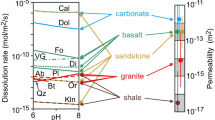Abstract
An empirical formula is presented to upscale the conductivity of 3-dimensional heterogeneous porous media, in which the distribution of local-scale conductivity is non-Gaussian with a high variance. The upscaled conductivity is determined as a function of the volumetric proportion, the spatial connectivity and the statistical geometric length of high-permeable inclusions, and the arithmetic mean of conductivities of all hydrofacies. A systematic comparison to other traditional upscaling methods indicates that this empirical formula provides a better estimation of the equivalent conductivity. In the second part of this study, numerical experiments of solute migration reveal that porosity also needs to be upscaled to capture the transport of contaminants in a heterogeneous medium using an effective or upscaled homogeneous medium. This is due to the tendency of contaminants to be preferrentially transported by 3-dimensional pathways composed of high-permeable materials in heterogeneous aquifer systems. The apparent difference between the actual transport velocity of contaminants and the upscaled velocity, based on the equivalent conductivity, forces upscaling of porosity. Further systematic analyses demonstrate that the upscaled porosity follows a non-linear trend as the content of high-permeable sediments decreases. Resultant upscaled porosity, with values varying between 0.004 and 1.5, is beyond the definition of the traditional porosity on the representative elementary volume (REV) scale. When the content of high-permeable materials is less than 30%, the upscaling of porosity is critical in the simulation of the contaminant transport in a heterogeneous medium using an upscaled, homogeneous counterpart.
Similar content being viewed by others
References
Pinczewski, W. V., Paterson, L., Preface: Transport in Porous Media, 2002, 46: 117.
Wen, X. H., Gomez-Hernandez, J. J., Upscaling hydraulic conductivities in heterogeneous media: An overview, Journal of Hydrology, 1996, 183(1–2): ix-xxxii.
Renard, P., Marsily, G. de., Calculating equivalent permeability: A review, Advances in Water Resources, 1997, 20(5–6): 253–278.
Gomez-Hernandez, J. J., Effective parameter estimation for flow and transport in the subsurface, Special publication, Journal of Hydrology, 1996, 183(1–2): 1–190.
Pinczewski, W. V., Paterson, L., Upscaling Downunder, Special publication, Transport in Porous Media, 2002, 46: 117–190.
Knudby, C., Carrera, J., Fogg, G. E., An empirical method for the evaluation of the equivalent conductivity of low-permeable matrices with high-permeable inclusions, Proceedings of the International Groundwater Symposium, Bridging the Gap between Measurement and Modeling in Heterogeneous Media. (ed. Findikakis, A. N.), Berkeley: Lawrence Berkeley National Laboratory, 2002.
Gelhar, L. W., Axness, C. L., Three-dimensional stochastic analysis of macrodispersion in aquifers, Water Resources Research, 1983, 19(1): 161–180.
Dykaar, B. B., Kitanidis, P. K., Determination of the effective hydraulic conductivity for heterogeneous porous media using a numerical spectral approach, 1. Method, Water Resources Research, 1992, 28(4): 1155–1166.
Dagan, G., High-order correction of effective permeability of heterogeneous isotropic formations of log-normal conductivity distribution, Transport in Porous Media, 1993, 12: 279–290.
Carle, S. F., Fogg, G. E., Modeling spatial variability with oneand multi-dimensional continuous Markov chains, Mathematical Geology, 1997, 29(7): 891–918.
Deutsch, C. V., Fortran programs for calculating connectivity of three-dimensional numerical models and for ranking multiple realizations, Computers and Geosciences, 1998, 24(1): 69–76.
Weissmann, G. S., Zhang, Y., LaBolle, E. M. et al., Dispersion of groundwater age in an alluvial aquifer system, Water Resources Research, 2002, 38(10): 1198.
Zhang, Y., Fogg, G. E., Simulation of multi-scale heterogeneity of porous media and parameter sensitivity analysis, Science in China, Series E, 2003, 46(5): 459–474.
Koltermann, C. E., Gorelick, S. M., Heterogeneity in sedimentary deposits: A review of structure-imitating, process imitating, and descriptive approaches, Water Resources Research, 1996, 32: 2617–2658.
Brown, W. F., Solid mixture permitivities, Journal of Chemical Physic, 1955, 23(8): 1514–1517.
Dagan, G., Analysis of flow through heterogeneous random aquifers by the method of embedding matrix, 1. Steady flow, Water Resources Research, 1981, 17(1): 107–122.
Noetinger, B., The effective permeability of a heterogeneous porous medium, Transport in Porous Media, 1994, 15: 99–127.
Webb, E. K., Anderson, M. P., Simulation of preferential flow in three-dimensional heterogeneous conductivity fields with realistic internal architecture, Water Resources Research, 1996, 32: 533–545.
Gomez-Hernandez, J. J., Wen, X. H., To be or not to be multi-Gaussian? A reflection on stochastic hydrology, Advances in Water Resources, 1998, 21(1): 47–61.
Fogg, G. E., Carle, S. F., Green, C., Connected-network paradigm for the alluvial aquifer system, Theory, Modeling and Field Investigation in Hydrogeology: A Special Volume in Honor of Shlomo P. Neuman’s 60th Birthday (eds. Zhang, D., Winter, C. L.), Boulder: Geological Society of America Special Paper 348, 2000, 25–42.
Loague, K., Abrams, R. H., Davis, S. N. et al., A case study simulation of DBCP groundwater contamination in Fresno County, California, 2. Transport in the saturated subsurface, Journal of Contaminant Hydrology, 1998, 29: 137–163.
LaBolle, E. M., Fogg, G. E., Role of molecular diffusion in contaminant migration and recovery in an alluvial aquifer system, Transport in Porous Media, 2001, 42: 155–179.
Hassan, A. E., Mohamed, M. M., On using particle tracking methods to simulate transport in single-continuum and dual continua porous media, Journal of Hydrology, 2003, 275: 242–260.
Guswa, A. J., Freyberg, D. L., Slow advection and diffusion through low permeability inclusions, Journal of Contaminant Hydrology, 2000, 46(3–4): 205–232.
Charbeneau, R. J., Groundwater Hydraulics and Pollutant Transport, New Jersey: Prentice-Hall, Inc., 2000, 9.
Peters, J. F., Howington, S. E., Holland, J. P. et al., Highperformance computing as a tool for groundwater cleanup, Journal of Hydraulic Research, 1998, 36(6): 897–912.
Bauer, S., Fulda, C., Schafer, W., A multi-tracer study in a shallow aquifer using age dating tracers3H,85Kr, CFC-113 and SF6-indication for retarded transport of CFC-113, Journal of Hydrology, 2001, 248: 14–34.
Author information
Authors and Affiliations
Corresponding author
About this article
Cite this article
Zhang, Y. Upscaling conductivity and porosity in three-dimensional heterogeneous porous media. Chin.Sci.Bull. 49, 2415–2423 (2004). https://doi.org/10.1007/BF03183431
Received:
Accepted:
Issue Date:
DOI: https://doi.org/10.1007/BF03183431




